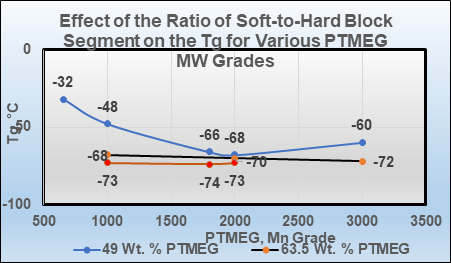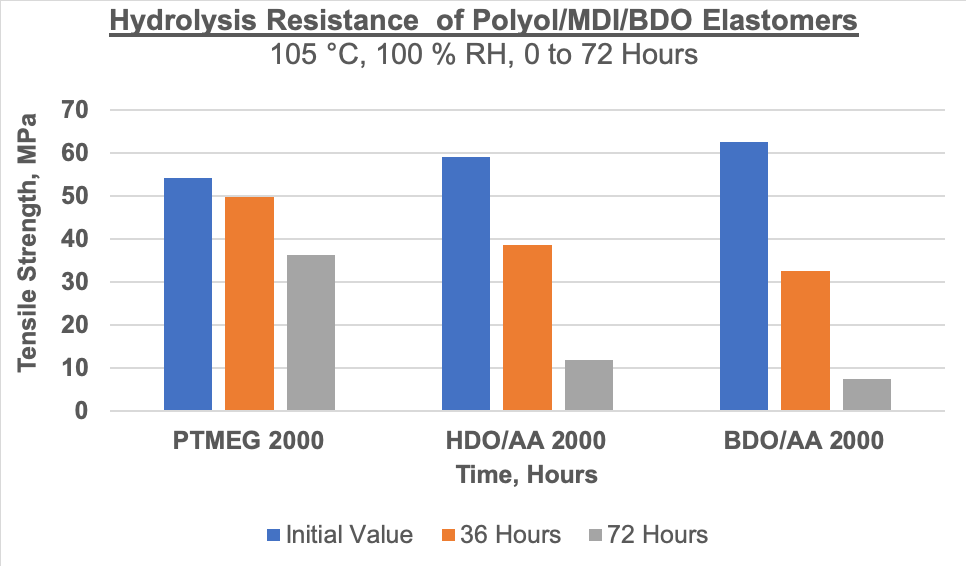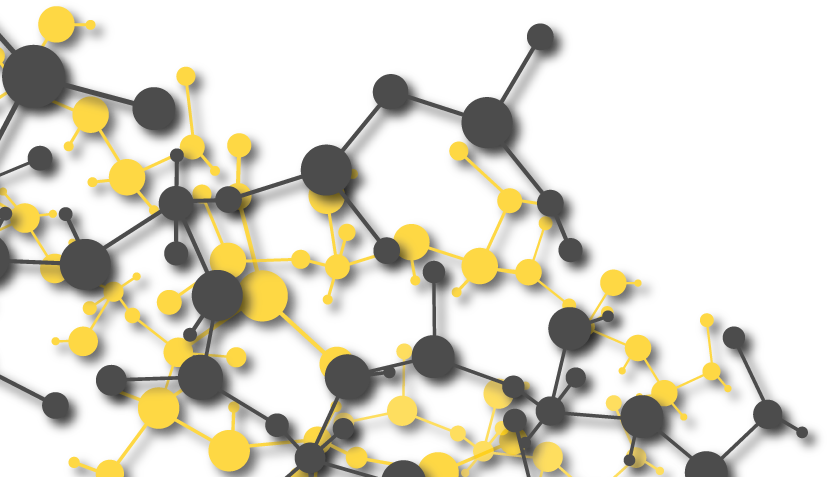Cast polyurethane elastomers based on 1,4-butanediol (BDO)-extended MDI systems using PTMEG as the soft segment are among the most useful polyurethane materials, offering cost and performance advantages. We see these elastomers used in a myriad of diverse cast urethane applications including wheels, heavy duty casters and tires for lift trucks, mowers; and all-terrain vehicles; industrial belts, wiper blades, and chute liners; pipe, hose, pump components, and tank liners used in abrasive service; mining, power, and oil-field equipment such as gaskets, valves, hydro cyclones, screens, and flotation parts; athletic shoes, boots and recreational equipment; and medical devices.
Advantages of the PTMEG/MDI/BDO polyurethane elastomers include superior hydrolysis resistance, maintenance of flexibility and other mechanical properties at low temperatures, high resiliency and rebound properties, superior resistance to impingement abrasion, good sliding abrasion resistance, impact resistance, and low dynamic heat build-up (low hysteresis).
In this article, we will provide formulation parameters for optimizing the performance of PTMEG/MDI/BDO systems.
The molecular weight grades of PTMEG diols range from 210 to 3000. By varying the hard block (MDI/BDO) and soft block (PTMEG) concentration and the molecular weight of the PTMEG segment, formulators can produce hot-cast elastomers with hardness ranges from the low Shore A range to the high Shore D range. The soft and hard segment contents also influence other properties such as tensile strength and modulus, low and high temperature performance, dynamic properties, resiliency, tear strength, and abrasion resistance.
PTMEG Molecular Weight Grades
PTMEG polyols present as liquids to waxy, white solids at room temperature, depending on the molecular weight. The PTMEG 210 and 650 grades are liquids with softening points at -5 °C and +11 °C, respectively. The higher molecular weight grades melt to clear, colorless, viscous liquids above room temperature. We’ve shown the chemical structure of these linear, polymeric, primary diols below.

In the empirical formula above, n ~14 for the 1000 MW grade and n ~27 for the 2000 MW grade. Butylated Hydroxytoluene (BHT) is the standard stabilizer used with PTMEG polyols, at 200-350 ppm.
While the workhorse grades of PTMEG in cast elastomers are the 1000 and 2000 MW diols, the PTMEG 210 and 650 grades are easier to handle liquids at room temperature and exhibit lower viscosities. The PTMEG 210 and 650 grades also allow the formulation of higher hardness PURs. When using a PTMEG/MDI prepolymer with low-free MDI, PTMEG 650 can be a useful formulation component to raise the hardness of the final elastomer. We also see PTMEG 650 used in blends to reduce the melting point of PTMEG 1000 to below room temperature.
Take a look at the specification of commercial grades available from Gantrade Corporation in the table below.
Specifications of Polytetramethylene Ether Glycol (PTG, PTMEG)
| Grade | Hydroxyl Number, OH (mg KOH/g) | Molecular Weight | Color, APHA | Acid Number (mg KOH/g) | Water (%) | Melting Point (°C) |
Flash Point, OC (°C) |
Density (g/cm3) at 40°C |
Viscosity (mPa•s at 40°C) |
| 210 | 477-606 | 185-235 | Max. 40 | Max. 0.05 | Max. 0.030 | -5 | Min. 160 | 0.98 | 30-50 |
| 650 | 166-180 | 625-675 | Max. 40 | Max. 0.05 | Max. 0.020 | 11 | Min. 230 | 0.978 | 160 |
| 1000 | 107-117 | 959-1049 | Max. 50 | Max. 0.05 | Max. 0.015 | 24 | Min. 260 | 0.977 | 268 |
| 1400 | 77-84 | 1336-1457 | Max. 50 | Max. 0.05 | Max. 0.015 | 27 | Min. 260 | 0.976 | 400 |
| 1800 | 60-65 | 1726-1870 | Max. 50 | Max. 0.05 | Max. 0.015 | 27 | Min. 260 | 0.975 | 1070 |
| 2000 | 53-59 | 1901-2117 | Max. 50 | Max. 0.05 | Max. 0.015 | 27 | Min. 260 | 0.974 | 1270 |
| 3000 | 35-39 | 2877-3206 | Max. 50 | Max. 0.05 | Max. 0.015 | 30 | Min. 260 | 0.974 | 3108 |

BDO as a Chain Extender
When it comes to MDI systems, 1,4-BDO is the chain extender of choice for most processors. BDO has a molecular weight of 90.12 and a hydroxyl value of 1245 mgKOH/g.
BDO reacts with MDI to create “hard segment” domains that efficiently microphase separately to afford tough elastomeric networks. Many studies have shown that the properties of a polyurethane are very dependent on the extent and perfection of this phase separation.
As revealed in the table below, the high degree of crystallinity and melt enthalpy (heat required to melt the crystalline hard segment) in MDI-BDO hard segments is particularly noteworthy. Modeling has shown that the molecular chains align better and inter-chain hydrogen bonding is facilitated with BDO as the chain extender.
Melt Enthalpy for MDI/Diol Segments in Polyurethanes
| Hard Block Chain Extender | ΔH(J/g)-TM | TM °C |
| EG | 0.9 | 175 |
| 1,3-PDO | 0.4 | 145 |
| BDO | 2.8 | 148 |
| 1,5-PDO | 0.14 | 167 |
| 1,6-HDO | 0.69 | 156 |
BDO is hygroscopic, so formulators must take precautions to keep BDO sufficiently dry to avoid moisture reactions with MDI. In this regard, Gantrade’s urethane grade of BDO has very low moisture levels, with a sales specification of < 150 ppm.
BDO is also a regulated substance with a potential for abuse in the value chain. As part of the Gantrade Corporation Product Stewardship process, we must document certain standard customer information and control measures prior to the sale and distribution of 1,4-BDO. The Gantrade Product Stewardship process serves to address the regulatory requirements and documents that the product is intended for safe, industrial use and applications.
Please see https://www.gantrade.com/faq/bdo for more information.
Mechanical Properties – PTMEG/MDI/BDO
The influence of the molecular weight of the PTMEG polyol and the weight percent of the PTMEG soft segment in the PTMEG/MDI/BDO polyurethane has been studied. As the % soft-to-hard block ratio increases in a polyurethane, the Shore A hardness decreases as does the tensile modulus, tensile strength, tear strength and compression set. The elongation at break and hydrolysis resistance increases with an increase in the PTMEG content.
In a systematic study, E. Pechhold and G. Pruckmayr observed the following effects of the molecular weight of the PTMEG and the soft segment content on the physical-mechanical properties of PTMEG/MDI/BDO polyurethane cast elastomers.
See: https://rubberchemtechnol.org/doi/abs/10.5254/1.3535877
- The Tg of the PTMEG/MDI/BDO elastomer decreases as the molecular weight of the PTMEG increases from PTMEG 650 to PTMEG 2000. Phase separation efficiency improves with higher molecular weights of the PTMEG. For example, Tgs varied from about -30 °C for the PTMEG 650 system to about -65 °C for PTMEG 2000, when the content of the soft segment was about 49 percent. Please note that a lower Tg affords better low temperature flexural and mechanical properties.
- The Tg of the soft block is dependent on the soft-to-hard block ratio. Particularly at soft-segment contents of 50 percent or less, the lower molecular weight grades show less efficient segment phase separations, resulting in higher Tgs. As the PTMEG content increases, phase separation improves and the Tg is more reflective of the Tg of the PTMEG soft block. This effect was most notable for PTMEG 1000, where the Tg decreases from -50 °C to -68 °C when the percent of the PTMEG 1000 increased from 48 percent to 63 percent. For PTMEG 2000, the effect of the soft-to-hard block concentration on the Tg is much less pronounced. We have provided data in the figure below, where the Clash-Berg temperature is used as a surrogate for the Tg.

- Bashore rebound/resilience increases with the weight percent of PTMEG in the PUR, and to a lesser extent, with the PTMEG molecular weight. PTMEG 2000 was markedly better in rebound and resilience versus PTMEG 650 and then PTMEG 1000 at the same concentration of the soft block. Note, the higher the Bashore rebound, the lower the hysteretic loss or heat build-up. (thus,Bashore rebound is inversely proportional to the hysteresis loss). Higher hysteresis is generally a negative property, since it can cause an excessive rise in the internal temperature of a specimen.
- The hydrolytic stability of PTMEG/MDI/BDO elastomers, as measured by the retention of properties after an exposure to water at 70 °C for two weeks, was notably better with higher molecular weight PTMEG grades and when the amount of the hard segment concentration was highest. Thus PTMEG 2000 showed a greater retention of properties versus PTMEG 1000 when studied from 52 weight percent hard segment down to 27 percent hard segment (See E. Peghhold and G. Pruchmayr, Rubber Chemistry and Technology, 55, 76 (1982)).
We have referenced the mechanical properties of a representative polyurethane based on a PTMEG 2000/MDI prepolymers and BDO as the chain extender in the table below. The table shows the effect of increased hard block content (higher NCO percentage) on the elastomeric properties. The tensile properties and tear strength increased with increased hardness (http://msdssearch.dow.com/PublishedLiteratureDOWCOM/dh_0963/0901b80380963c80.pdf?filepath=polyurethane/pdfs/noreg/628-76201.pdf&fromPage=GetDoc).
| Mechanical Properties of MDI-PTMEG 2000 Prepolymer with BDO Chain Extender | |||
| NCO, % | 12.8 | 8.20 | 6.60 |
| Wt. PTMEG in PUR, % | 48 | 62 | 67 |
| Hardness, Shore A | 96A | 90A | 85A |
| 100% Modulus, psi | 2500 | 1100 | 830 |
| Tensile Strength, psi | 5100 | 4800 | |
| Elongation, % | 500 | 560 | |
| Tear Strength, pli | 540 | 500 | |
| Bashore Rebound, % | 64 | 70 | |
Hydrolytic Stability of PTMEG/MDI/BDO Elastomers
An interesting test compared the hydrolysis resistance of MDI/BDO elastomers based on PTMEG 2000 with elastomers based on two adipate polyester polyols of MW 2000. The elastomers were prepared by chain extending MDI prepolymers with BDO in the molar ratio of 1:3:2, Polyol/MDI/BDO. The NCO/OH index was 1.05.
The testers determined tensile strength retention under extreme conditions of superheated steam at 105 °C and 100 percent relative humidity. The results are shown in the figure below for PTMEG 2000 vs. 1,6-hexanediol adipate and 1,4-butanediol adipates.
 Source: Daicel Corporation, Highly Hydrolysis Resistant Polyols, Document No. 20130164
Source: Daicel Corporation, Highly Hydrolysis Resistant Polyols, Document No. 20130164
After 72 hours at 105 °C and 100 percent RH, the PTMEG/MDI/BDO elastomer showed a 67 percent retention of the initial tensile strength. The HDO adipate and the BDO adipate elastomers showed 72-hour retentions of 20 percent and 12 percent respectively. The data, derived under extreme conditions, demonstrates the superior hydrolysis resistance of the PTMEG polyols.
Conclusion
We designed this discussion to illustrate the property sets that can be achieved with PTMEG/MDI/BDO cast elastomers by using the various molecular weight grades of PTMEG that are commercially available, and by varying other parameters such as the hard-to-soft block weight ratios. The PTMEG soft segment mainly affects the elastomeric and dynamic properties and low temperature performance. The MDI/BDO hard segment influences the hardness, tear, cut and chip resistance.
Other enhancements such as increased tensile properties, tear and abrasion resistance, and hydrolytic stability are possible by incorporating low levels of triols such as trimethylolpropane (TMP) or by optimizing the stoichiometric isocyanate index (up to 1.05 excess of MDI versus the theoretical 1:1 ratio).
To explore how PTMEG/MDI/BDO systems can address your company’s unique needs, partner with Gantrade. Our team, armed with a wealth of technical knowledge and expertise, can guide you to the best solutions for your applications. Contact Gantrade today to get started. We offer a wide portfolio of products for CASE, polymers & resins and polyurethane applications.













